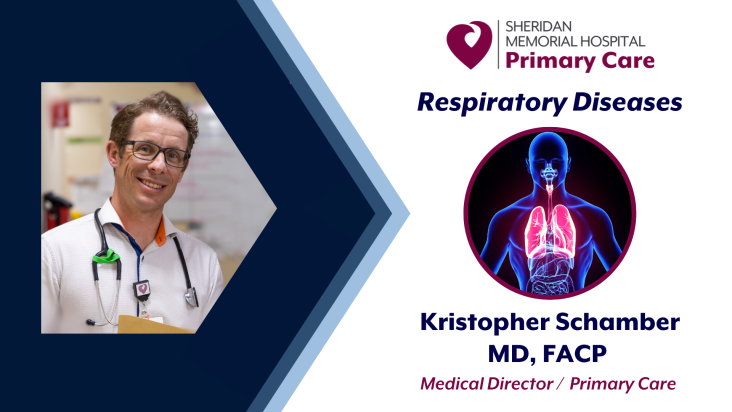By Kristopher Schamber, MD, FACP – Medical Director, SMH Primary Care
There are a number of different respiratory diseases and associated treatments in adults, though a few are much more common than others. Here’s a look at six common respiratory diseases, their symptoms, causes and treatments.
Chronic obstructive pulmonary disease (COPD)
COPD is caused by damage to the lung tissue and the airways into and through the lungs, typically from tobacco smoke or exposure to substances such as coal dust, silica dust, welding fumes and caustic chemicals. There is a rare genetic disorder by the name of alpha-1 antitrypsin deficiency that can also cause this disease. Typical symptoms include shortness of breath, cough with phlegm and tightness or heaviness in the chest. COPD flares occasionally and can be triggered by tobacco smoke, wildfire smoke, pollen and other allergens, strong odors, cold air, pneumonia or bronchitis. Treatment includes cessation of smoking, oxygen if needed, and inhaled medications. Smoking cessation and oxygen use are the only things that prolong life in this disease, and everything else is geared toward symptom improvement and preventing hospitalization.
Asthma
Asthma is a lung disease similar to COPD in which the airways are inflamed. It is caused by a combination of genetic and environmental factors, including smoke and others. Asthma tends to be more severe in younger patients and can be very dangerous very quickly. It is treated similarly to COPD. Triggers are also very similar to COPD.
Pneumonia
Pneumonia is a term that indicates infection in the lungs. Pneumonia is caused by many different bacteria (staph, strep and others) and viruses (influenza, RSV, rhinovirus, COVID and others). Pneumonia can occur randomly, but certain factors increase the risk, including underlying lung disease like COPD, asthma or cystic fibrosis; history of childhood lung infections; or a depressed immune system from medications or certain medical conditions. Treatment is tailored to the specific cause. For example, antibiotics are used to treat bacterial pneumonia. Only a few viral pneumonias have specific treatments, including influenza and COVID. Treatment may also include oxygen, if needed, inhalers and fluids to help treat dehydration. Certain types of pneumonia can be prevented with vaccination. The most common type of bacterial pneumonia has a vaccine that is given typically after the age of 65. There are also COVID and influenza vaccinations that can help prevent pneumonia from these viruses.
Lung cancer
Lung cancer is most commonly associated with tobacco smoke and coal dust in this country. However, it can occur without these risk factors. A person with lung cancer may have no symptoms early in the disease process. Symptoms, when present, include cough, shortness of breath, chest pain, fevers, chills, sweats, weight loss and others if the cancer has spread to other areas of the body. Screening for lung cancer occurs primarily in adults age 50–80 who have smoked one pack per day or more for 20 years or more, and who are currently smoking or quit within the last 15 years. Coalminers also have access to specific lung cancer evaluation through the NOWCAP Black Lung Clinic.
Pulmonary embolism
Pulmonary embolism, or blood clots in the lungs, occur primarily in people who had recent surgery, long travel without any movement (more than three hours), active cancer, leg injuries, estrogen or testosterone therapy or blood clotting disorders. Symptoms include shortness of breath, chest pain particularly with deep breathing, and a racing heart. Pulmonary embolism is diagnosed with a CT scan and is treated with blood thinning medications.
Pulmonary edema
Pulmonary edema, or fluid in the lungs, occurs primarily as a consequence of heart failure. When a heart pump is not working, fluid backs up into and around the lungs. Symptoms include shortness of breath, especially with activity and lying down to heavy chest, and cough. Treatment includes diuretics (“water pills”) and treatment of the underlying heart disease.
Safe oxygen use
If you are on oxygen for a lung or a heart condition, it is important that you follow certain safety procedures. You should not smoke or be near any open flame, including campfires or cooking sources. Do not use electrical appliances such as hair dryers, curling irons, heating pads or electric razors. Use only cotton sheets to limit static electricity. Do not use aerosol sprays near the oxygen unit; do not use petroleum-based products or ointments as these are flammable; and do not use alcohol-based hand sanitizers. Also, always have a fire extinguisher nearby.
Listen to the latest Doc Talk as Dr. Schamber discusses
Respiratory Diseases in person at The Hub.
To learn more about the hospital’s Primary Care Clinic and Dr. Schamber, go to their webpage: https://www.sheridanhospital.org/medical-services/clinics/primary-care/

